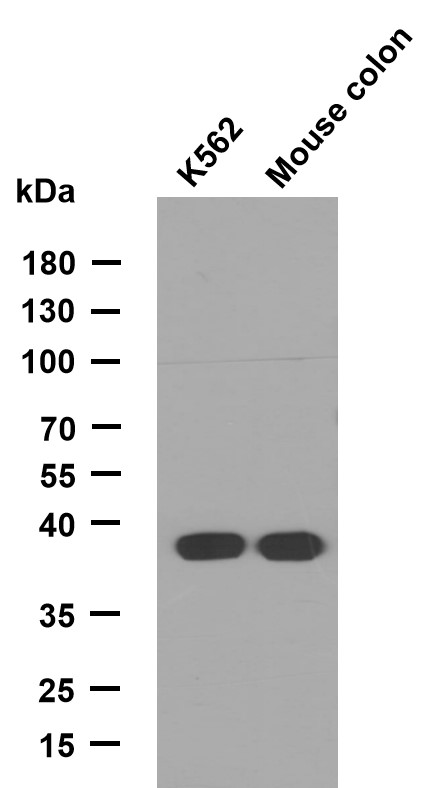MUC1 (ABT100) mouse mAb
- Catalog No.:YM6810
- Applications:IHC;ELISA
- Reactivity:Human;
- Target:
- Mucin 1
- Gene Name:
- MUC1 PUM
- Protein Name:
- Mucin-1 (MUC-1) (Breast carcinoma-associated antigen DF3) (Carcinoma-associated mucin) (Episialin) (H23AG) (Krebs von den Lungen-6) (KL-6) (PEMT) (Peanut-reactive urinary mucin) (PUM) (Polymorphic epi
- Human Gene Id:
- 4582
- Human Swiss Prot No:
- P15941
- Immunogen:
- Synthesized peptide derived from human Epithelial Membrane Antigen(MUC1) AA range: 100-200
- Specificity:
- The antibody can specifically recognize human MUC1 protein.
- Formulation:
- PBS, 50% glycerol, 0.05% Proclin 300, 0.05%BSA
- Source:
- Mouse, Monoclonal/IgG1, kappa
- Dilution:
- IHC 1:50-200. ELISA 1:500-5000
- Purification:
- The antibody was affinity-purified from ascites by affinity-chromatography using specific immunogen.
- Storage Stability:
- -15°C to -25°C/1 year(Do not lower than -25°C)
- Other Name:
- Mucin-1 (MUC-1;Breast carcinoma-associated antigen DF3;Carcinoma-associated mucin;Episialin;H23AG;Krebs von den Lungen-6;KL-6;PEMT;Peanut-reactive urinary mucin;PUM;Polymorphic epithelial mucin;PEM;Tumor-associated epithelial membrane antigen;EMA;Tumor-associated mucin;CD antigen CD227) [Cleaved into: Mucin-1 subunit alpha (MUC1-NT;MUC1-alpha);Mucin-1 subunit beta (MUC1-beta;MUC1-CT)]
- Molecular Weight(Da):
- 122kD
- Observed Band(KD):
- 122kD
- Background:
- This gene encodes a membrane-bound protein that is a member of the mucin family. Mucins are O-glycosylated proteins that play an essential role in forming protective mucous barriers on epithelial surfaces. These proteins also play a role in intracellular signaling. This protein is expressed on the apical surface of epithelial cells that line the mucosal surfaces of many different tissues including lung, breast stomach and pancreas. This protein is proteolytically cleaved into alpha and beta subunits that form a heterodimeric complex. The N-terminal alpha subunit functions in cell-adhesion and the C-terminal beta subunit is involved in cell signaling. Overexpression, aberrant intracellular localization, and changes in glycosylation of this protein have been associated with carcinomas. This gene is known to contain a highly polymorphic variable number tandem repeats (VNTR) domain. Alternate sp
- Function:
- alternative products:Additional isoforms seem to exist,caution:O-glycosylation sites are annotated in first sequence repeat only. Residues at similar position are probably glycosylated in all repeats. Experimental sites were determined in a synthetic peptide glycosylated in vitro (PubMed:7744025, PubMed:9597769).,caution:The N-terminal sequence has been shown (PubMed:11341784) to begin at position 24 or 28.,developmental stage:During fetal development, expressed at low levels in the colonic epithelium from 13 weeks of gestation.,function:The alpha subunit has cell adhesive properties. Can act both as an adhesion and an anti-adhesion protein. May provide a protective layer on epithelial cells against bacterial and enzyme attack.,function:The beta subunit contains a C-terminal domain which is involved in cell signaling, through phosphorylations and protein-protein interactions. Modulates s
- Subcellular Location:
- Cytoplasmic, Membranous
- Expression:
- Expressed on the apical surface of epithelial cells, especially of airway passages, breast and uterus. Also expressed in activated and unactivated T-cells. Overexpressed in epithelial tumors, such as breast or ovarian cancer and also in non-epithelial tumor cells. Isoform Y is expressed in tumor cells only.
- June 19-2018
- WESTERN IMMUNOBLOTTING PROTOCOL
- June 19-2018
- IMMUNOHISTOCHEMISTRY-PARAFFIN PROTOCOL
- June 19-2018
- IMMUNOFLUORESCENCE PROTOCOL
- September 08-2020
- FLOW-CYTOMEYRT-PROTOCOL
- May 20-2022
- Cell-Based ELISA│解您多样本WB检测之困扰
- July 13-2018
- CELL-BASED-ELISA-PROTOCOL-FOR-ACETYL-PROTEIN
- July 13-2018
- CELL-BASED-ELISA-PROTOCOL-FOR-PHOSPHO-PROTEIN
- July 13-2018
- Antibody-FAQs
- Products Images

- Human gastric adenocarcinoma tissue was stained with Anti-MUC1 (ABT100) Antibody

- Human kidney tissue was stained with Anti-MUC1 (ABT100) Antibody

- Human lung adenocarcinoma tissue was stained with Anti-MUC1 (ABT100) Antibody

- Human mesothelioma tissue was stained with Anti-MUC1 (ABT100) Antibody

- Human pancreas tissue was stained with Anti-MUC1 (ABT100) Antibody



